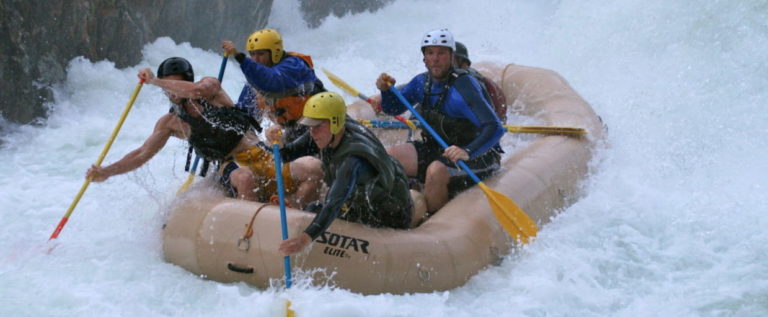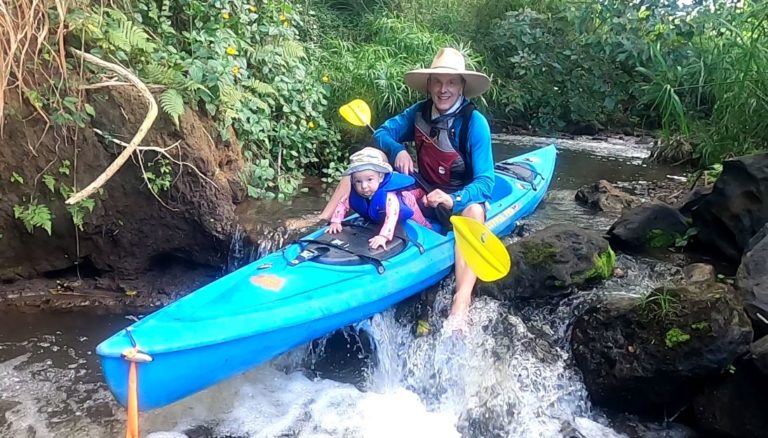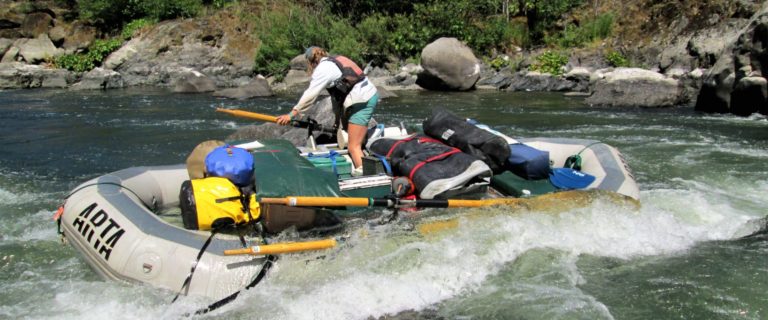The most important aspect of whitewater rafting life jackets is flotation. This article looks at how flotation impacts the amount of time swimmers spend under water as well as other advantages of high flotation PFDs. If you are not a big fan of reading check out this video discussing the importance of flotation with my friend Zach Collier.
There are many reasons why people don’t select a high float PFD: how it fits, how it looks, where the pockets are, what color it is, it’s easier to move and swim in low float jackets. Yes, these are all considerations when selecting a whitewater PFD. However, flotation actually makes it easier to swim and carrying a bunch of stuff in your pockets is counter productive.
Quick disclaimer, this article is about whitewater life jackets/ PFDs for rafting. While everything in this article would also be true for a swim while whitewater kayaking, high flotation life jackets make multiple aspects of kayaking challenging.
Best Whitewater PFDs for Swimming Rapids
Many people discuss how it is more challenging to swim in a high float life jacket but how many have tried swimming the same rapid in both a high float and low float jacket?
I have. High float rafting life jackets make it easier to stay on top of the river where the current is slower. They allow me to have more control regarding where I go. It is easier to make my arm recovery being more above the water than in it. Crossing eddy lines is less work and I have an improved vantage point by sitting higher in the water. When swimming in a wave train I feel like I was swimming over the waves rather than through them.
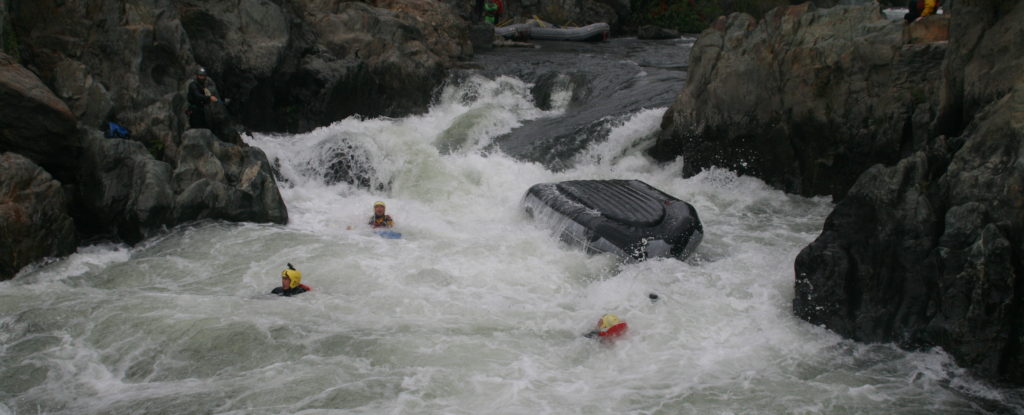
Why 16 lb flotation PFDs?
“Most people will naturally float in water, especially if they fill their lungs with air. Most require only about 11 pounds of extra buoyancy to keep their heads out of water. That is why a PFD with just 15-1/2 pounds of buoyancy can provide flotation for an adult— even a large person.”
lifejacketassociation.org
The 16 lb flotation life jacket is based upon the US Coast Guard MINIMUM REQUIREMENTS. These regulations are based upon flat water situations not the whitewater environment. A fairly unique aspect of whitewater sports is the river pushing people underwater. In this situation it is necessary for the flotation of the vest to do more than keep someone afloat. The flotation needs to counter the force of the river taking a person underwater.
More flotation means a person’s head is less likely to go underwater and if it does it will be under for less time. Additional flotation will also keep the head higher out of the water making it easier to see and breath. Interestingly, the Coast Guard requires some types of PFD’s to have a minimum of 22 lbs of flotation.
Listen to Zach and Aaron Discuss PFD Flotation
When People Decide They Need More Flotation
The question I have for the lovers of low volume vests is: How often have you seen someone take a bad swim and say they wish they had LESS flotation? Anyone who has spent time around the river has seen that person who’s head is just inches underwater but not breaking the surface as they are twirled down a nasty eddy fence. We’ve all had swims or seen people take swims where additional flotation would have improved the situation. Below are a few examples.
Mas-o-Menos – Futaleufu River
Mas-o-Menos Rapid is a high volume rapid on the Futaleufu with a series of huge breaking waves and a few holes. A guide fell out of the back of his raft and immediately went deep. After what seemed like an eternity he surfaced with no energy left. Luckily there was a safety cataraft within reach. The guide said he isn’t sure what would have happened if the safety cataraft had not been there. He had been wearing a worn-out high float vest. The next week he anxiously waited for a customer coming from the US with a new high float vest.
Grey’s Grindstone – Tuolumne River
At the top of Grey’s Grindstone a guide school raft flips in the hole on river right during high water. The instructor, a larger guy around 240 lbs in a low float jacket, has to be rescued and has by far the worst swim of the group. All the other less experienced rafters in the boat had high float jackets are were not held down nearly as long.
Grey’s Grindstone II – Tuolumne River
Grey’s Grindstone in 1997, a commercial raft flips in the entrance hole. The guide ends up dying and guests are fine. The guests were wearing the old 32 lb flotation vests and wetsuits while the guide had a 16 lb PFD and had burped ALL the air out of his drysuit.
Guides on flips routinely take the deepest swims particularly back when the America’s Cup (32 lb) rafting PFDs were standard guest vests.
Some Thoughts About Maximizing Flotation
While choosing a rafting life jacket with more flotation can dramatically improve the outcome for a whitewater swim in the river, there are some other details that can positively effect a swim.
Fill Those Lunges
Don’t under estimate how much a big breath helps. Lunges full of air provide an extra 4 or 5 lbs of flotation! Check out the photos below.
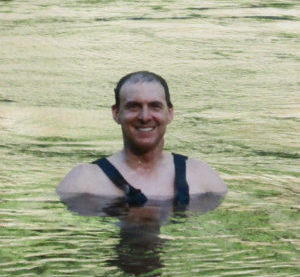
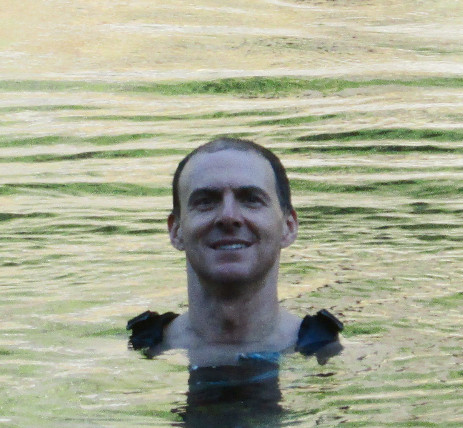
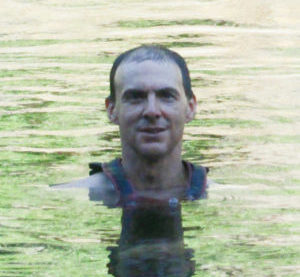
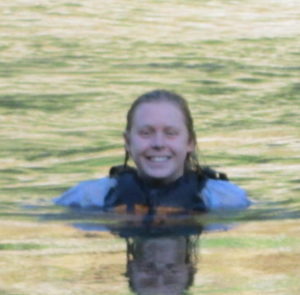
Keep Life Jacket Flotation Low on your Body
Wearing your PFD lower on your body will improve its performance. Flotation has to be submerged in the river to help float a person. By wearing a PFD lower on your torso (as in the 1st photo above) all of the life jacket is in the water when the swimmer is floating at equilibrium.
The more flotation below the surface of the water the greater the force lifting the person out of the water. Any flotation that is not in the water is actually sinking you (extra weight) rather than helping float you.
Minimizing Drag
Swimmers shave hair to reduce drag when racing which makes a measurable difference. A study showed by 5%. Hair is a minimal amount of drag compared to what we as rafters and kayakers wear on our bodies. By minimizing drag – having less gear hanging off you like those cool board shorts you wear over your wetsuit, you can reduce your drag dramatically. Having less drag means the river has less control on where you go and you have more.
Extra flotation also impacts drag. We know that the higher humans float on the surface of the water the less resistance (drag) they have from the water and the faster they can swim. Surfers, think about paddling a longboard versus a shortboard.
A couple more not regularly discussed problems with drag. Whitewater swimmers are carried underwater partially by drag allowing the river to apply force to a swimmer. Extra drag also increases the amount of time it takes your life jacket to get you back to the surface.
Benefits of Swimming on your Stomach
Most of the flotation is on the chest of a whitewater PFD. Swimming on your stomach means more of your flotation is in the water an will help you float high in the water. Watch people who try to float very flat on their backs and you’ll notice they float low in the water because most of their flotation is out of the water. I’m not recommending always swimming on your stomach. There are times to swim on your stomach and this is another advantage.
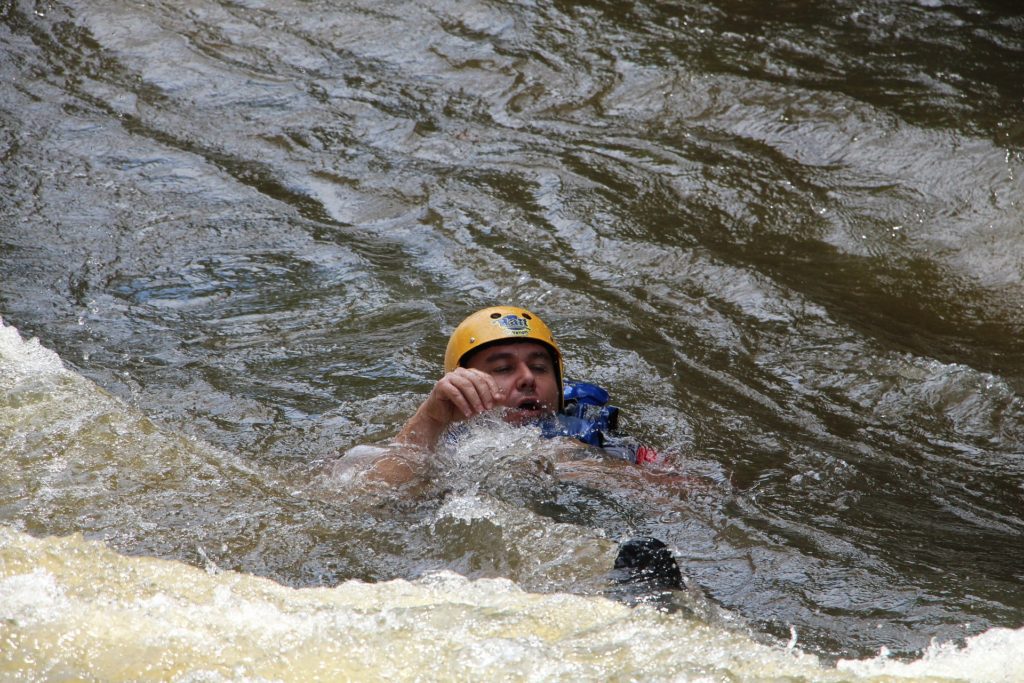
Flotation of Some Popular Life Jackets
24 lbs to 28 lbs 9oz: MTI Atlas, their new version of the Big Buoy.
22 lbs jackets: Extrasport Universal and Fury, NRS Big Water and Rapid

The NRS Big Water, the most popular high volume rafting PFD currently on the market.
18 – 22 lbs: Stohlquist Kahuna
16 to 18 lbs: Kokatat Maximus, Guide, and Ronin Pro
17.5 lbs: NRS Zen
16 lbs: Astral Green
7 lbs 6 oz: Stohlquist Infant PFD for children weighting up to 30 lbs.
Argument for High Flotation Life Jackets Through Math
If you want more detail than is provided or if there are errors in my calculations please let me know.
Carrying Extra Weight in your Rafting PFD
Another factor to consider is carrying heavy gear in your rafting PFD. A 16 lb flotation life vest with pulleys and carabiners becomes approximately 15 lbs. Three carabiners and two pullies counter about 1 lb of flotation. On a 16 lb vest that is 6%. Meaning you are around 3% longer to return to the surface. This may seem insignificant but at some point your head may not get a chance to break the surface before another wave due to the lack of flotation.
How Long will you be Underwater?
If we compare a low float kayaking PFD carrying wrap equipment (15 lbs) to the one of the higher float (26 lbs) pfd, it is a 69% increase in flotation. That means about 21.6% decrease in the amount of time underwater.
Wetsuits Add Flotation
Wetsuits can easily provide an extra 5 lbs of flotation plus excellent padding in case you fall out of the raft. A person wearing a high float rafting life jacket (26 lbs) and wetsuit (5 lbs) compared with another person in just a low float jacket with hardware (15 lbs) will see 30.4% less time underwater or 44% longer depending upon the way you do the math. That means being underwater for 10 seconds instead of almost 15 seconds. While each individual addition and subtraction to flotation may seem to be small, they add up.
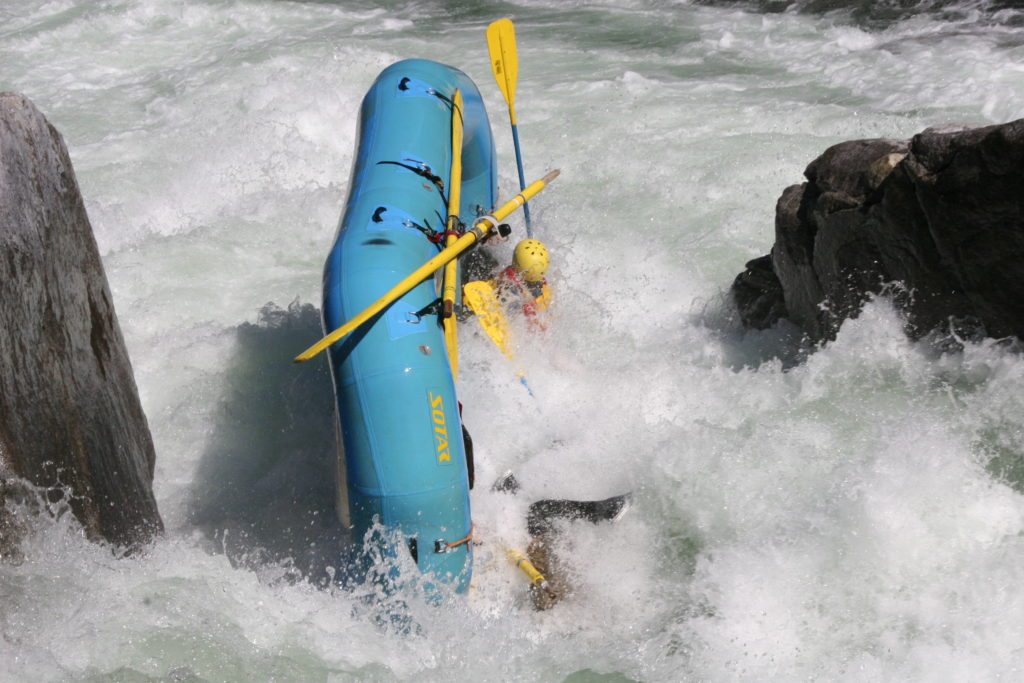
Maintaining your Life Jacket
There are ways to extend the life of a PFD. Minimize the time it spends in the sun. The material holding the foam can get worn to the point that it will rip. I’ve seen people swimming in rapids with foam floating next to them. Using 303 Protectant on vests and other river gear minimizes the UV degradation.
Also, rinse PFDs in clean water after muddy rafting trips and salt water kayaking excursions. Life jackets need to be totally dry before putting away. Finally, make sure to not compress the foam. Sitting on your vest or even worse storing it under something heavy will compress the foam and cause it to loose some of its flotation power.
When to Replace your Life Jacket
Ideally a whitewater life jacket is replaced before you notice it needs to be replaced. Meaning, if your vest looks faded and worn out or it clearly doesn’t float you well anymore it is past its life. If the foam seems brittle or dents when squished and doesn’t rebound afterwards it’s time for a new vest. The best way to check flotation is to compare to your friends new vest.
Concluding Thoughts
Hopefully this article on PFDs and flotation has you thinking a little more about the importance of being prepared to swim whitewater. Having a life jacket with extra flotation, minimizing the weight in your pockets and minimizing drag on your body will give you the best opportunity to have an uneventful swim when rafting. Please send me a note if you have any questions or comments.
You might enjoy our articles on selecting the right rafting footwear and our review of baby carriers.
